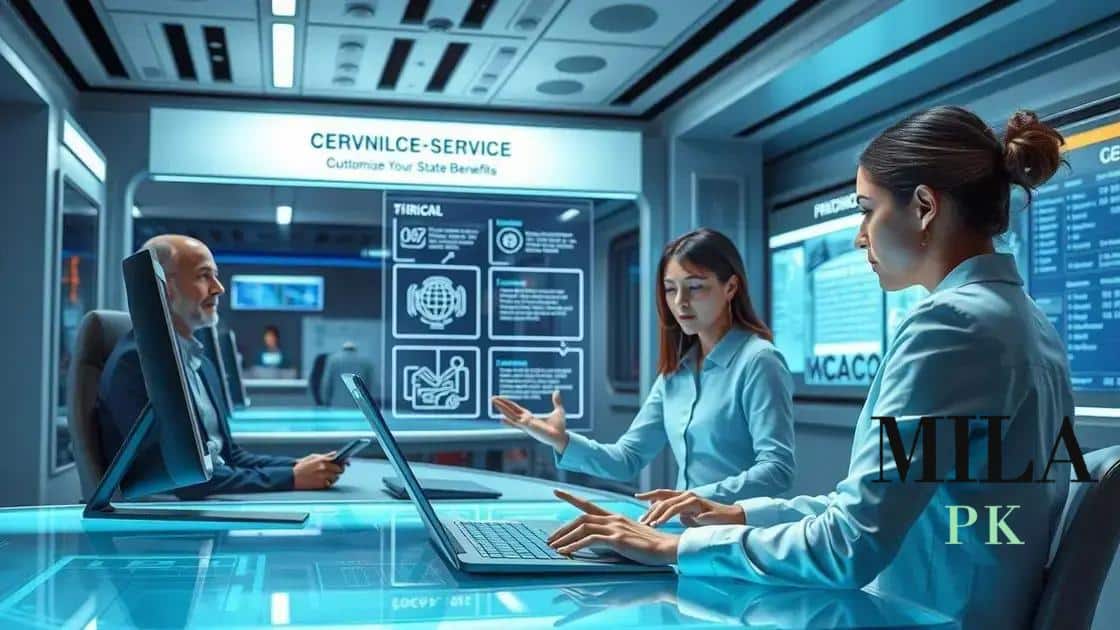State-based benefits see increased customization in 2025

State-based benefits in 2025 will focus on increased customization, leveraging technology for personalized services, and enhancing community involvement to better meet individual needs.
State-based benefits see increased customization in 2025, reshaping the landscape of government services. Ever wondered how personalized approaches can enhance your experience with these benefits? Let’s dive into the details.
Understanding state-based benefits
Understanding state-based benefits is crucial for anyone seeking assistance from government programs. These benefits are designed to help individuals and families meet their basic needs, such as healthcare, housing, and education. Understanding how these programs work can empower citizens to access the support they are entitled to.
What are State-Based Benefits?
State-based benefits are programs funded by the government at the state level. They provide a safety net for residents facing financial hardships. Each state may have different eligibility requirements and options available. Typically, the benefits are aimed at low-income families, children, the elderly, and individuals with disabilities.
- Types of state-based benefits include food assistance, healthcare programs, and employment support.
- Eligibility often depends on income and family size.
- Applications for benefits can often be completed online or at local government offices.
Understanding the range of benefits available can help individuals make informed decisions. For example, some programs offer cash assistance, while others focus on providing medical care or job training. Each type of benefit has its own guidelines.
Eligibility Criteria
To qualify for state-based benefits, applicants typically need to provide documentation regarding their income, household size, and sometimes even their employment status. States aim to ensure that resources are allocated fairly and to those who need them most. If you’re considering applying for these benefits, here are some common eligibility conditions:
- Income limits that vary by state and family size.
- Residency requirements that mandate applicants live in the state.
- Age limits that may apply to certain programs.
Indeed, navigating these programs can be daunting. However, many organizations offer assistance in completing applications and understanding eligibility requirements. It is advisable to reach out to local agencies or advocacy groups for support.
In conclusion, by understanding state-based benefits, individuals can better navigate their options and obtain necessary support. This knowledge fosters self-sufficiency and ensures that people can access necessary resources during challenging times.
The role of customization in 2025

The role of customization in 2025 is shaping how state-based benefits are delivered. Personalization is becoming key to ensuring that services meet the specific needs of citizens.
What is Customization?
Customization refers to the ability to tailor services to individual preferences and situations. In 2025, state programs are moving toward greater flexibility. This helps to improve user satisfaction and accessibility.
- Personalized communications help recipients understand their options better.
- Targeted services allow for more efficient resource allocation.
- Feedback mechanisms involve citizens in shaping their experiences.
By focusing on customization, states can create tailored approaches to benefit delivery. This means that citizens can receive services that resonate more with their circumstances. Customization facilitates improved communication and transparency, allowing individuals to feel more connected to the programs.
Technological Advances
Technology plays a pivotal role in enabling this customization. In 2025, we see the integration of advanced data analytics and artificial intelligence. These tools allow for a more detailed understanding of needs and preferences.
With the right technology, states can:
- Analyze user data to identify trends.
- Create personalized user experiences on digital platforms.
- Streamline application processes to save time and improve access.
As technology evolves, so does the ability of state-based programs to adapt and serve their populations better. The aim is to ensure that every individual can access the benefits they require without unnecessary barriers.
Embracing customization is not just about enhancing services. It’s about creating a partnership between the government and its citizens, ensuring everyone feels valued and supported in their journeys toward well-being.
How technology drives personalization
How technology drives personalization has transformed the landscape of state-based benefits. In 2025, advancements in technology enable programs to tailor services to individual needs.
Innovative Technologies at Work
Several technologies play crucial roles in creating personalized experiences. Machine learning algorithms analyze user data, providing insights into the specific needs of citizens. This information allows states to design programs that are both responsive and relevant.
- Data analytics help identify patterns in user behavior.
- Artificial Intelligence streamlines service delivery by predicting user preferences.
- Mobile applications allow for easy access to information and services.
By utilizing these technological tools, governments can engage with their populations more effectively. Customization of service delivery helps ensure that resources reach those who need them most, enhancing overall user satisfaction.
Enhancing User Experience
Technology also fosters an improved user experience. Personalized online platforms engage citizens through interactive features. These features make it easier for individuals to apply for benefits, ask questions, and receive timely updates.
For example, chatbots provide 24/7 assistance, answering common queries regarding state benefits. This immediate support alleviates confusion and minimizes delays in obtaining necessary services. Citizens feel more connected and informed, enhancing trust between them and the government.
In this highly digitized environment, personalization is no longer an option; it’s a necessity. As states integrate technology into their services, they must prioritize user-centric designs. This shift not only improves efficiency but also builds a sense of community and reliance on government support.
Case studies of successful implementations
Case studies of successful implementations highlight how states are enhancing their benefit programs through effective customization. These examples showcase innovative approaches that prioritize user needs and technological integration.
State A: Leveraging Technology for Personalized Benefits
State A implemented a new digital platform that allows residents to access state-based benefits tailored to their specific circumstances. By using data analytics, the state can predict and address the needs of its population.
- The platform integrates user feedback to constantly improve services.
- Residents can receive alerts regarding benefit updates directly on their smartphones.
- This system has increased user satisfaction by 40% since its launch.
State A’s proactive approach illustrates how technology can drive significant improvements in service delivery and user experience.
State B: Community-Centric Approaches
Another example comes from State B, where the government partnered with local organizations to provide personalized support services. This collaboration has strengthened community ties and ensured that services are relevant and accessible.
Through this initiative, community workers help residents navigate complex benefit applications. They also host workshops to educate citizens about their options. This hands-on support has resulted in a 30% increase in benefit enrollment.
By investing in community resources, State B has successfully tailored its approaches to meet the diverse needs of its residents.
State C: Feedback-Driven Innovation
State C has embraced a feedback-driven model, allowing users to share their experiences and suggestions directly with program administrators. This real-time feedback has led to quick adjustments in service delivery.
- Surveys and focus groups gather essential data from users.
- Swift implementation of changes based on user input keeps services relevant.
- The program has gained widespread support, with many residents feeling valued and heard.
This model demonstrates how engaging with the population can lead to ongoing improvements in state-based benefits.
Future predictions for state-based benefits
Future predictions for state-based benefits reveal exciting trends that will shape support systems. As we look ahead, it is clear that innovations in technology and shifts in public policy will influence how benefits are delivered to citizens.
Increased Personalization
One major prediction is a rise in personalized benefits. By leveraging big data and artificial intelligence, states will be able to tailor programs to meet the unique needs of each individual. This customization will ensure that resources are allocated effectively, maximizing the impact of state support.
- Services will adapt based on user feedback and changing demographics.
- Communication will become more targeted, providing relevant information directly to those who need it.
- Users will experience enhanced engagement through interactive services.
This personalized approach will likely lead to improved outcomes for families and individuals, making state-based benefits more effective than ever before.
Emphasis on Technology Integration
The ongoing integration of technology will also be significant in shaping the future. In 2025, we expect to see state programs utilizing advanced technologies for streamlined operations. Enhanced connectivity will allow for better collaboration among agencies, leading to greater efficiency.
For instance, the implementation of cloud-based systems will support real-time data sharing, making it easier for agencies to coordinate services. This interconnectedness will reduce redundancy and improve the user experience.
- Automated systems will help in quickly processing applications.
- Mobile platforms will make accessing benefits more straightforward.
- Data analysis will inform policy adjustments, making benefits more responsive.
Such advancements will transform how benefits are accessed, ultimately fostering a more seamless experience for users.
Community Involvement and Feedback
Another prediction is that community involvement will play a more pivotal role in shaping benefits. States are increasingly recognizing the value of engaging with citizens to gain insights into their needs and preferences. This shift will lead to more collaborative solutions that reflect community values.
As citizens share their experiences, benefits will evolve based on direct input. Involvement can include:
- Regular community forums to discuss challenges and solutions.
- Focus groups that provide feedback on service delivery.
- Surveys that gauge satisfaction and identify areas for improvement.
By prioritizing community input, the future of state-based benefits can be truly reflective of the people they serve, ensuring ongoing relevance and efficacy.
FAQ – Frequently Asked Questions about State-Based Benefits
What is the significance of personalization in state-based benefits?
Personalization helps tailor services to individual needs, ensuring that citizens receive the support that is most relevant to them.
How does technology influence the delivery of benefits?
Technology streamlines processes, enhances communication, and allows for real-time data sharing, making it easier for individuals to access benefits.
Why is community involvement important in shaping state programs?
Community involvement ensures that programs are reflective of the actual needs and preferences of citizens, leading to more effective service delivery.
What can we expect for the future of state-based benefits by 2025?
By 2025, we anticipate increased personalization, better technology integration, and more robust community engagement in state-based benefit programs.





